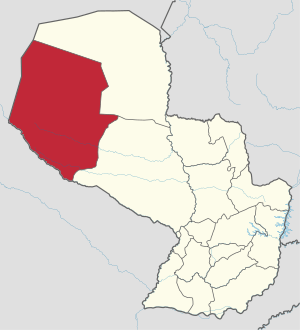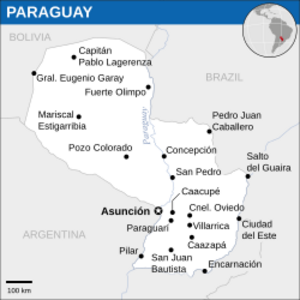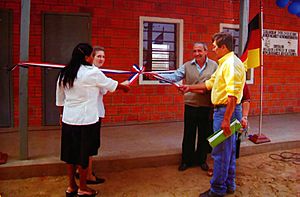Boquerón department facts for kids
Quick facts for kids
Boquerón Department
|
|||
|---|---|---|---|
|
|||
 |
|||
| Country | |||
| Capital | Filadelfia | ||
| Number of Districts | 3 | ||
| Area | |||
| • Total | 91,669 km2 (35,394 sq mi) | ||
| Population
(2021)
|
|||
| • Total | 68,080 | ||
| • Density | 0.74267/km2 (1.92351/sq mi) | ||
| Time zone | UTC-04 (AST) | ||
| • Summer (DST) | UTC-03 (ADT) | ||
| ISO 3166 code | PY-19 | ||
Boquerón is a large area in the western part of Paraguay. It's called a department. It's the biggest department in the country.
Even though it's huge, it has one of the smallest populations. In 2021, about 68,080 people lived there. The capital city of Boquerón is Filadelfia.
This department is home to several Russian Mennonite communities. These include Fernheim, Menno, and Neuland. Other important towns are Loma Plata and Mariscal Estigarribia.
In 1945, Boquerón was divided into two parts. The northern part was named "Chaco." The remaining southern part kept the name "Boquerón." The capital moved to Filadelfia. Later, in 1992, the Chaco department joined back with Boquerón. This made the department big again, like it was before 1945. Filadelfia remained its capital.
Contents
Exploring Boquerón's Location
Boquerón Department is in the western part of Paraguay. It's located between certain lines on a map, called parallels and meridians. It covers a huge area of about 91,669 square kilometers. This makes it a bit larger than countries like Hungary.
What Borders Boquerón?
Boquerón shares its borders with different places:
- North: It borders the Alto Paraguay Department. A straight line and a railway separate them.
- South: It borders Argentina. The Pilcomayo River forms this border.
- East: It borders the Presidente Hayes Department. A road and an imaginary line separate them. It also borders the Alto Paraguay Department in some parts.
- West: It borders Bolivia. An imaginary line marks this border.
Boquerón's Nature and Weather
This part of Paraguay is very dry. It has small streams, but their beds are often empty. The weather here is a mix of warm dry, tropical, and humid climates. Rain doesn't fall often during the dry season. But when it does rain, it can cause quick floods.
The average rainfall is low, especially in the north. The highest temperature ever recorded in Paraguay was in Boquerón. It reached 45.0 degrees Celsius (113 degrees Fahrenheit) in 2009.
Plants and Trees in Boquerón
The trees in this area are usually short and have thorns. You can also find bushes and cactus plants. Some parts have sand dunes and small hills.
Some trees in this region are becoming rare. These include the urunde'y, white and red quebracho, and samu'u (also called palo borracho). The palo santo tree is also found here.
Who Lives in Boquerón?
Boquerón is growing fast, with more people moving there each year. It's known for its diverse population. Many Native Americans live here. There are also Mennonites, Paraguayans, and people from Brazil.
In 2002, about 45,617 people lived in Boquerón. Almost half of them were Native Americans. They belong to different groups like Nivaclé, Ayoreos, and Guaraní-Ñandéva. Most of Paraguay's native population lives in this department.
Main Towns and Their Populations
Here are some of the towns and their populations from 2002:
- Filadelfia: 7,750 people
- Loma Plata: 6,500 people
- Yalve Sanga: 4,200 people
- Mariscal Estigarribia: 2,000 people
- Neu-Halbstadt: 720 people
- Choferes del Chaco: 600 people
How Boquerón is Governed
The department is divided into six main areas called districts. These districts help manage the region. The districts are:
- Filadelfia
- Loma Plata
- Mariscal Estigarribia
- General Eugenio A. Garay
- Doctor Pedro P. Peña
- Neuland
For a long time, Boquerón had only one district. In 2006, Loma Plata and Filadelfia became new districts. Filadelfia also became the capital. More recently, General E. A. Garay, Doctor P. P. Peña, and Neuland were added as districts.
The local government helps run schools and hospitals. It also has departments for health, education, and the environment. There are also groups that help Native Americans, women, and young people.
Learning in Boquerón
Boquerón has many schools, with about 9,000 students and over 450 teachers. This includes private schools and places that teach job skills. Most people over 15 years old can read and write.
One big challenge for students and teachers is the long distances. It can be hard to get to school, which sometimes makes students leave. Some areas don't have enough teachers for all the classes.
Staying Healthy in Boquerón
The department has four private hospitals. The government also runs a regional hospital in Mariscal Estigarribia. They also support a center for mothers and children. Many people live in Filadelfia, Loma Plata, and other main towns.
Native Americans get healthcare from private groups. Some have health insurance, but not all. There are 23 health centers in the department.
The Mennonite communities have their own private health insurance. They have a well-organized health system. Healthcare is a very important need in Boquerón, especially since many people live in poverty.
Boquerón's Economy
The main way people earn money in Boquerón is through cattle farming and dairy production. They raise cows and produce milk, cheese, and meat. These products are even sold to other countries. There are many cattle owners, with hundreds of thousands of cows.
Every day, about 450,000 to 500,000 liters of milk are produced. This makes up a big part of the economy in the Central Chaco area.
Making things from leather is also important. They make saddles and shoes. Farmers grow crops like bananas, lemons, oranges, tangerines, beans, sweet potatoes, onions, pumpkins, corn, peanuts, and sorghum.
Getting Around and Communicating
Boquerón has some paved roads, but many are not paved. This can make travel hard, especially when it rains or during dry seasons. If you plan to travel there, it's smart to bring water, food, fuel, and an emergency kit.
The Mennonite communities often help fix and maintain the roads themselves. They know the area very well.
The Mariscal Estigarribia district has an airport for different types of planes. In some areas, people have modern technology like TV, internet, and cell phones. But in other places, it's hard to communicate because of the land. Some Ayoreo natives still live in remote areas and are not used to modern life.
Radio stations are very important for communication. "La Voz del Chaco Paraguayo AM" broadcasts across the whole western region. It reaches places where other communication is difficult. There's also "Radio Médano" and two community radio stations.
Fun Things to Do in Boquerón (Tourism)
Rural and nature tourism is becoming popular in the Central Chaco. Visitors can see how the people who settled there live and adapt. Many tourists and students visit the native villages and the farming communities. They often enjoy learning about the cattle and other industries.
The old forts of Boquerón, Toledo, and Isla Po'í are also popular. These places still have signs of the Chaco War. This war is a very important part of Paraguay's history.
Boquerón's Symbols
Boquerón has its own flag and a special badge. The song Chaco Boreal is the department's anthem. These symbols were first shown to the public on September 29, 1995. This happened at Fort Toledo, with many students present.
See also
 In Spanish: Departamento de Boquerón para niños
In Spanish: Departamento de Boquerón para niños





